Patmos: The Island We Love to Return to
Charming architecture, unique beaches, rich history,...
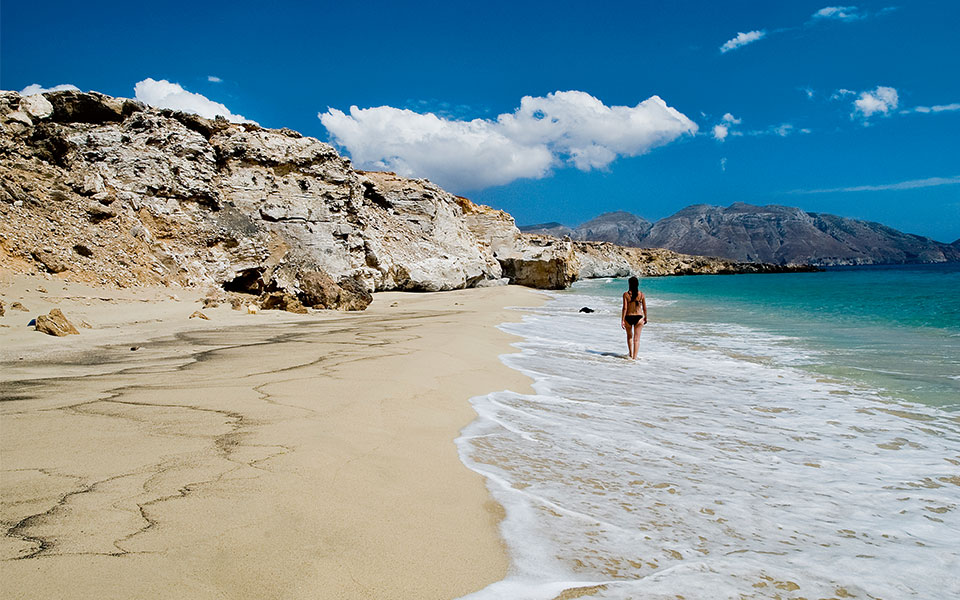
Marmara Beach on the islet of Armathia, a slice of heaven just a short boat ride away.
© Clairy Moustafellou
STARTING POINT: Early in the morning, enjoy a Greek coffee together with the fishermen at Matheos’ kafeneio in the small harbor of Bouka, next to the bigger port of Fri. You’ll see fish being bought and sold outside, but you’ll also hear vivid accounts of Kasos’ history, which is dominated by the story of the Turkish-Egyptian armada setting fire to the island in 1824, and by tales of adventures at sea, as Kasos has always been home to seafarers. Sea captains, ship owners and sailors have always defined everything here, from food to festivals and the interior design of homes, and they still do. To learn more, visit the Nautical Museum (Open daily 10:00-13:00).
A LOOK INSIDE: In the afternoon, stroll around the villages of Aghia Marina (with its gorgeous sunset colors), Arvanitochori and Panaghia, all within close distance of Fri. Observe the majestic churches with their imposing bell towers, and the captains’ houses in pastel colors, and don’t hesitate to ask to have a peek inside – Kasiots rarely say no. You’ll spot shelves laden with porcelain plates and other decorative objects, brought back by the sailors from their travels. Notice the columns in the center of the houses, on which a headscarf is hung: the pillar supports the roof and symbolizes the man of the house, the absent captain.
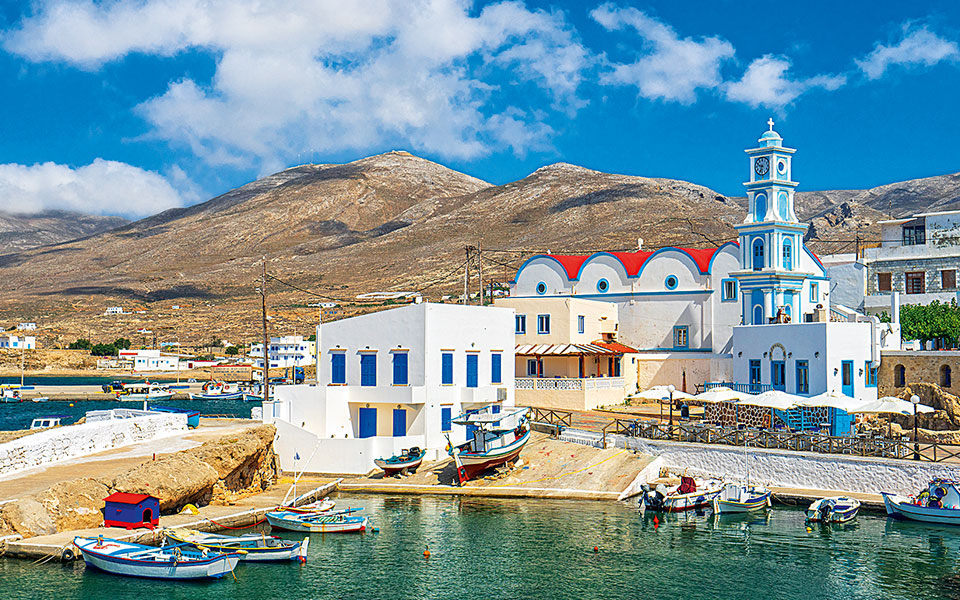
The small harbor of Bouka, in Fri.
© Perikles Merakos
JOIN IN THE FUN: Kasos is one of the very few Aegean islands where traditional feasts retain their authentic, non-commercial character. You’ll be impressed to see how the white-aproned men cook the pilaf rice and then form a human chain to serve it, passing the traditional glass plates from hand to hand. The revelry begins with mantinades (narrative songs made up of rhyming couplets) in honor of the saint being celebrated. The tempo of the music varies from song to song, and no one leaves before dawn.
THE SOUND OF MUSIC: There are more than 60 different Kasiot rhythmic song patterns. Their “sacred” tune is the alenti, and you’ll recognize it by the enthusiasm or emotion of the performer. It is the most difficult of all songs, but also the sweetest. The pear-shaped lyres of the Dodecanese, with kounia (bows bearing tiny bells), survive only in Kasos, Karpathos and Halki. Children learn to play instruments at a young age. Traditional dances, such as the sousta and zervos, and the art of the mantinada seem to run in their blood.
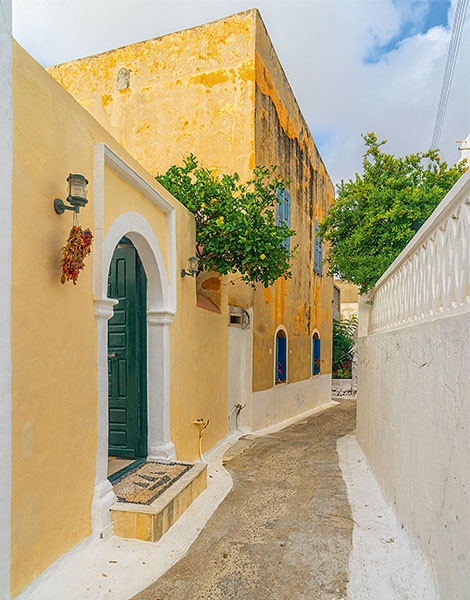
Homes built by wealthy sea captains in Arvanitohori.
© Perikles Merakos
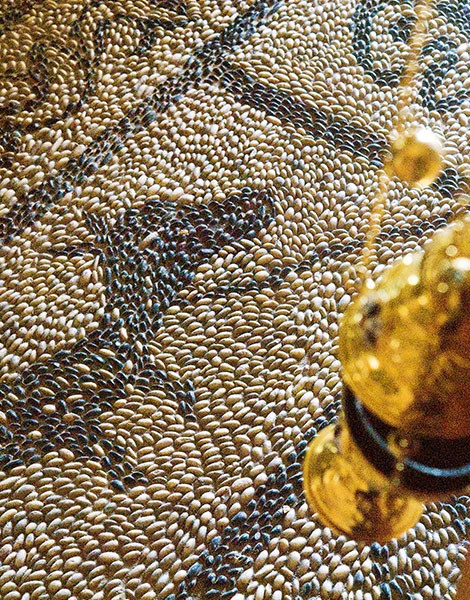
The pebble-mosaic floor inside the Church of Aghios Mamas, from the mid-19th century.
© Julia Klimi
SOMETHING DIFFERENT: You can spend a night at the Monastery of Aghios Georgios, patron saint of Kasos, at Hadies, in the southwest. Its secluded location is enchanting. If you notify the keeper of the monastery in advance, you will be treated to a dinner of ofto, a dish of slow-roasted lamb. Municipality of Kasos (Tel. (+30) 22450.412.77).
BEACHES AND BEST SWIMS: From Fri you can reach Helatros Beach, on the southeast tip of the island, by way of a beautiful, winding, 14-km route. Helatros is a sandy bay with emerald waters and a sense of isolation, despite Mary Dimitriou’s food stand (where she serves tasty home-made burgers) and a scattering of beach umbrellas. For complete isolation, the pebble beaches of Trita and Avlaki can be reached after an hour’s downhill walk from the Monastery of Aghios Georgios.
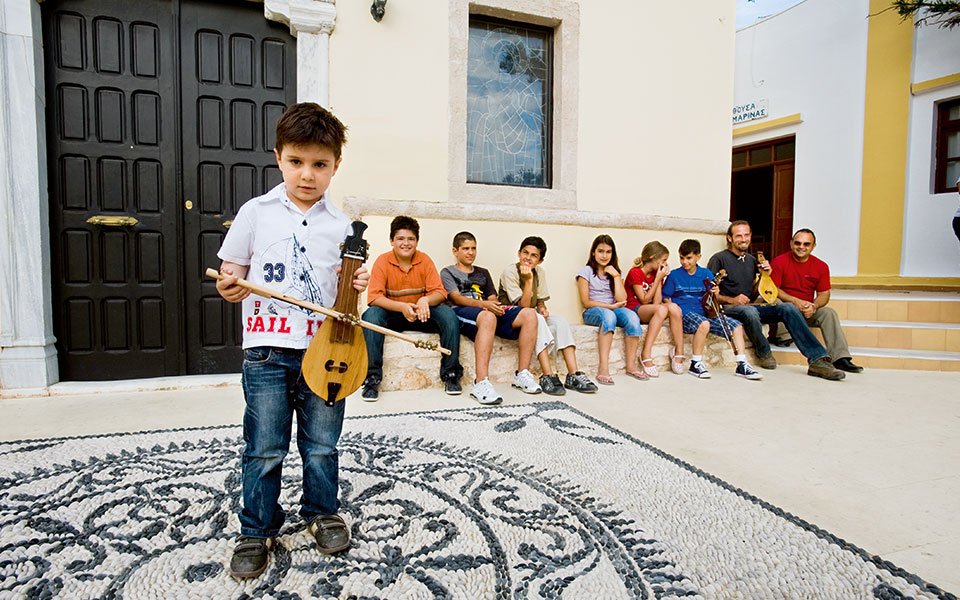
On Kasos, children learn from a young age to play the lyra and dance traditional dances: it’s a way of life.
© Clairy Moustafellou
LITTLE PARADISE: Marmara is considered one of the most beautiful beaches in Greece, not only for its fine white sand and blue waters, but also for the sense of seclusion it offers – it’s located on the uninhabited islet of Armathia across from Kasos. You can get there on Giorgos Manousos’ boat (Tel. (+30) 22450.410.47).
A SCENIC ROUTE: From Poli, the island’s former capital, it’s a pleasant drive to the chapel of Aghia Kyriaki with its stunning views (the sunrise from here is exceptional). The same route will also take you to the 19th-c. Monastery of Aghios Mamas in the northeast, built in a magnificent location full of craggy outcroppings and with a boundless view over the sea. The annual festival, held here every September 2, is quite a moving experience.
ART THERAPY: In Fri, seek out the Old Dispensary, where an arts and crafts exhibition featuring local artists runs throughout the summer.

The sandy stretch at Helatro Beach with its crystal-clear waters.
© Julia Klimi
ALL THAT’S GOOD: As a rule, Kasiots use whatever they produce locally, so what is referred to on other islands as the “traditional local dish” is, in fact, just part of everyday life here. Definitely try the dormaes (miniscule stuffed vine leaves); the seafood, no matter how bizarre it may appear (Mediterranean parrotfish prepared whole with scales and entrails intact; grooved shellfish cooked in seawater; or salted blotched picarel); and, above all, the famous makarounes with sitaka and onions sauteed in fresh butter.
SAY CHEESE: Kasiot farmers produce excellent cheeses, including sitaka, myzithra (a ricotta-style cheese), as well as elaiki, a type of myzithra that’s aged for 2-3 months in butter. Other products include drilla (sour cream from goat’s milk) and psitari, a special local butter. Visit a mitato, or shepherd’s hut, to learn about cheese production in fascinating detail (trivia: the stirring stick is made of ram’s horn or a special kind of wood). Ask them to make you some alevra – a porridge of milk and flour drenched with melted Kasiot butter and eaten straight out of the cauldron. The only fully modernized, certified dairy is Bonapartis (Tel. (+30) 22450.419.53).
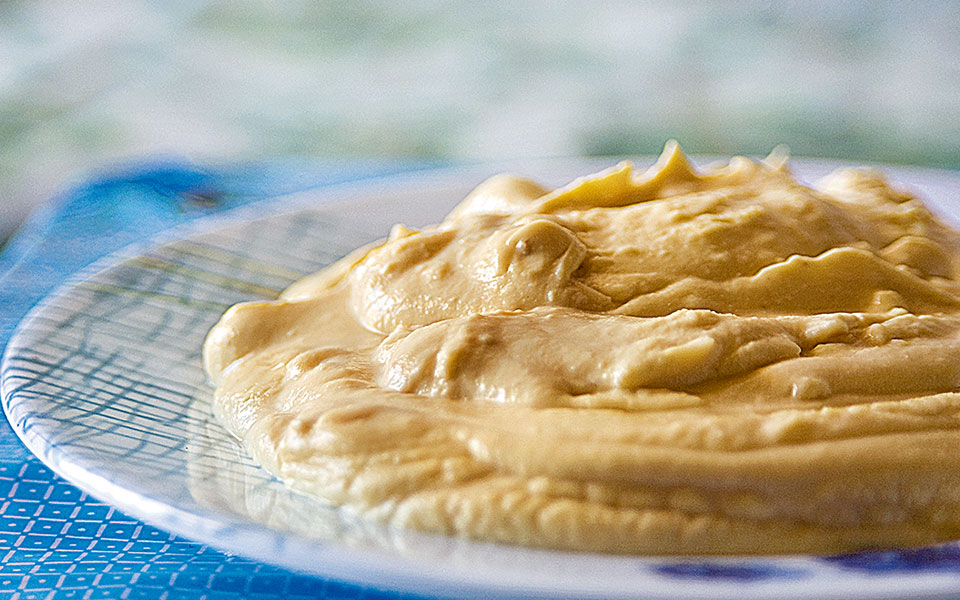
Sitaka, a soft, sweet-and-sour cheese, is best enjoyed with a kouloura rusk or mixed in with makarounes.
© Julia Klimi
FROM THE SOURCE: You can buy local honey either from shops or directly from beekeepers such as Antonis Sevastos, who also makes candles, beeswax ointments, rakomelo liqueur and more, and sells them at the Mylos Taverna in Fri.
HUNGRY? For breakfast or for special treats, there is the café Chez Jean in Bouka, serving homemade savory pies, pastries and honey dumplings, and Plateia Café, which has ice cream, waffles and diples (crisp, sheet-like fritters with walnuts and honey). For Kasiot desserts, including xerotigana (the local version of diples), xylikopites (fried dough with honey) and moschopoungia (sweet aromatic crescent-shaped pies stuffed with almonds), head to Koula’s pastry shop in Fri.
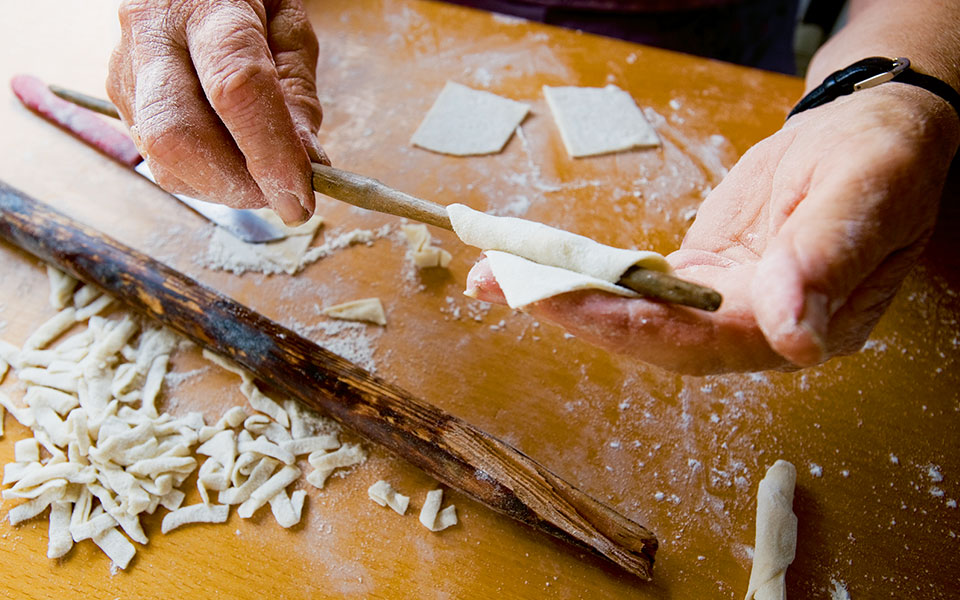
Making makarounes, the local pasta.
© Clairy Moustafellou
BEST RESTAURANTS: After a dip at the popular beach of Emporio, you can enjoy a good meal at the small taverna of the same name; it belongs to Giorgos Kikis and Mihalis Aspras and is famous for its excellent food, which includes lobster spaghetti, fresh fish, spiny chicory and snails. The spontaneous revelry that may erupt is an added bonus – one of the owners plays the lyre while the other sings. In Arvanitochori, check out Maroukla’s, not so much for the souvlaki as for the lively village atmosphere of the small square on which this kafeneio sits.
For a glass (or two) of ouzo, some delicious mezes and some unusual dishes, stop by the brand-new Yiaeli at Bouka. Try the feta with honey in filo pastry or their makarounes topped with sitaka cheese, with garlic, or with hand-minced pork. If you order it in advance, you can try the lamb with pasparas (liver, rice and tomatoes) stuffing. At Meltemi in Fri, enjoy stuffed calamari, skate with skordalia (a strong garlic dip), and squid cooked in wine, in a rustic setting appropriate to the seafood they serve. Local flavors and homestyle cooking are available at Mylos Taverna in Fri and at Steki in Aghia Marina.
Charming architecture, unique beaches, rich history,...
From ancient healing sanctuaries to legendary...
Patmos Aktis, Resort & Spa combines...